TOP 10+ Leading Hospital Visitor Management Systems in 2025
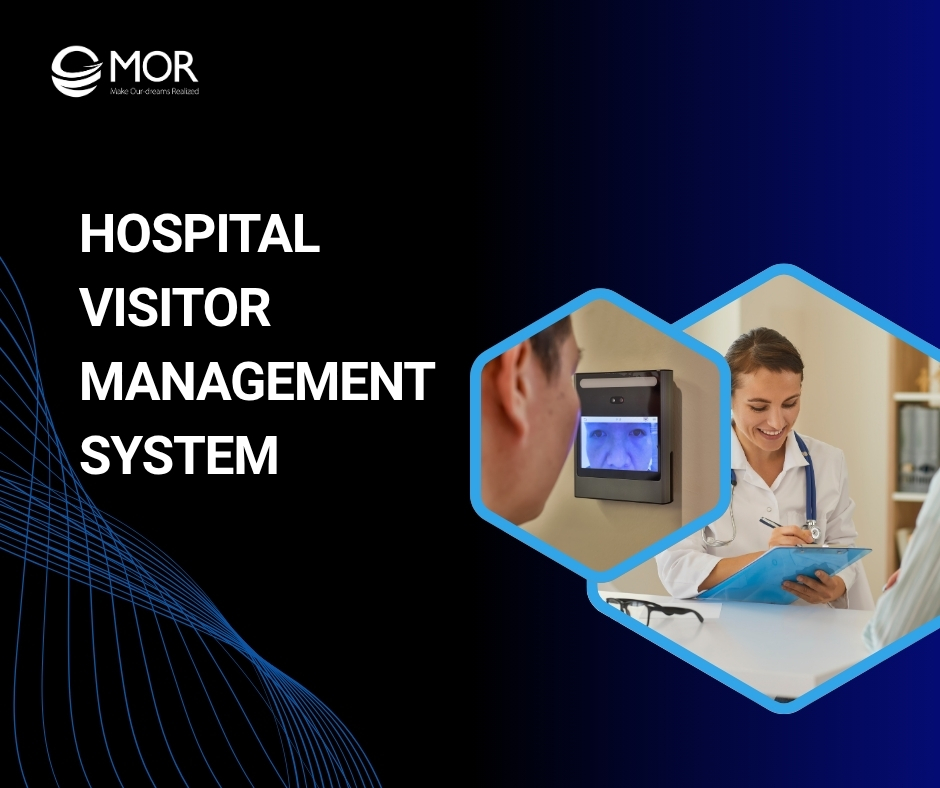
Hospitals can’t afford guesswork when it comes to managing daily foot traffic. A reliable hospital visitor management system keeps patients safe, protects staff, and eliminates messy paper logs. This MOR Software’s guide will help you explore the top solutions available, understand must-have features, and choose the right visitor management system for hospitals in 2025.
What Is Hospital Visitor Management System?
A hospital visitor management system is a digital tool that helps hospitals handle who enters and exits their facilities. It tracks each visitor’s arrival, records why they’re there, and monitors their movements while on-site.
Some tools are as simple as a digital sign-in app, while others are complex platforms with ID scanning, AI workflow automation watchlist detection, access control integration, and instant alerts for staff.
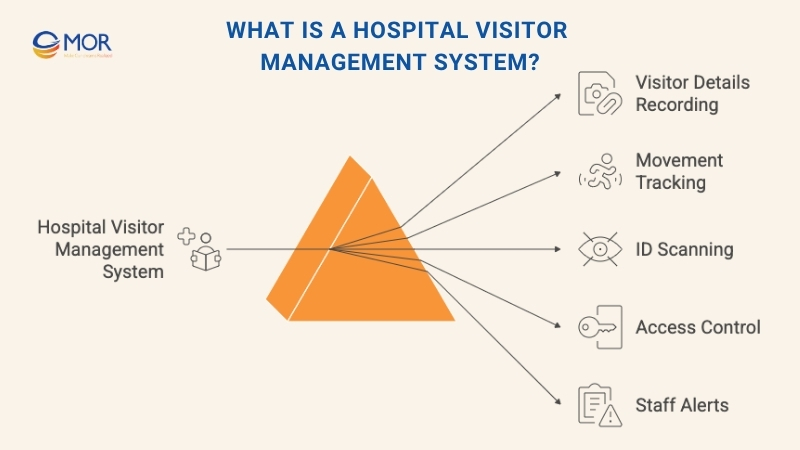
Whether you're running a private clinic or a large medical center, the right system keeps your building secure without slowing things down. Nearly 30% of hospitals have reported unauthorized access incidents tied to outdated or manual visitor tracking methods, according to Pilobi.
Now, we’ll move on to breaking down what to expect from a reliable visitor management system for hospitals, which features matter most, and how to pick a solution that improves security, operations, and the overall guest experience.
Key Benefits Of Hospital Visitor Management System
Hospitals face constant pressure to stay secure, stay compliant, and stay efficient. A strong hospital visitor management system supports all three by putting control back into the hands of staff, without slowing down the guest experience.
- Enhanced safety: Not every visitor should have free access. A modern visitor management system for hospitals screens each guest, flags matches against internal or government watchlists, and limits movement in restricted zones. It helps security teams know who’s inside, where they’re headed, and when they arrived. ACRE reports that hospitals using visitor management systems have seen a 35% reduction in unauthorized access incidents.
- Infection control: With health still a top concern, touchless check-in matters. These systems allow pre-screening questions, contactless entry, and fast access approval. That helps prevent the spread of illness while creating a safer environment for patients and staff.
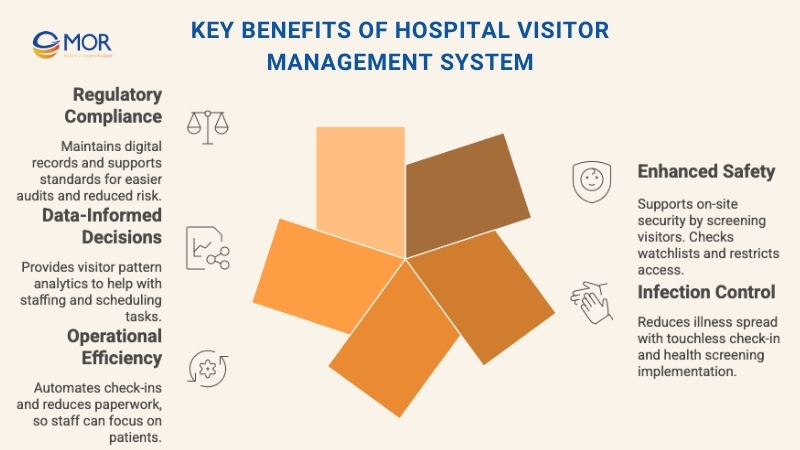
- Operational efficiency: Paper sign-in sheets slow everyone down. A hospital visitor management system automates daily check-ins, frees up reception staff, and cuts down on manual data entry. The result? Less paperwork, faster processing, and more time for teams to focus on care. According to ACRE, digital check-in tools reduce average processing times by up to 72%.
- Data-informed decisions: When are the busiest hours? How long are visitors staying? Built-in analytics reveal these patterns, helping hospitals allocate staff and adjust schedules. These insights make the healthcare visitor management system more than just a check-in tool, it becomes a planning asset.
- Regulatory compliance: Compliance isn’t optional. A reliable visitor management system hospital setup keeps accurate digital logs, tracks visitor behavior, and supports HIPAA, OSHA, CDC, and Joint Commission requirements. The Ponemon Institute reports that hospitals using visitor management platforms experience 40% fewer data-related security incidents, showing the value of better tracking and record-keeping.
>>> If you want to learn more about Visitor Management System for Office, just READ NOW!
Core Features To Look For In Hospital Visitor Management System
Choosing the right visitor management healthcare system means knowing what tools actually matter in a high-pressure healthcare setting. Look for features that support speed, safety, and scalability without adding more complexity to daily operations.
- Fast, touchless check-in / kiosk or mobile QR: Visitors should be able to check in within seconds, no pens, no paperwork. Whether through a kiosk or their phone, touchless QR check-ins help reduce wait times and limit unnecessary contact.
- Real-time tracking / occupancy dashboards: Staff need to know who’s inside and where they are. Live dashboards show current guest locations, helping teams monitor high-traffic areas and manage capacity in sensitive zones.
- Pre-registration & appointment scheduling: Let guests pre-fill forms and book visit times in advance. A visitor management system for hospitals that supports pre-registration speeds up entry and minimizes front desk traffic.
- ID scanning and badge printing: Verify each visitor’s identity and print badges that clearly show who they are, why they’re there, and how long they’re authorized to stay. This helps staff and security quickly spot unauthorized access.
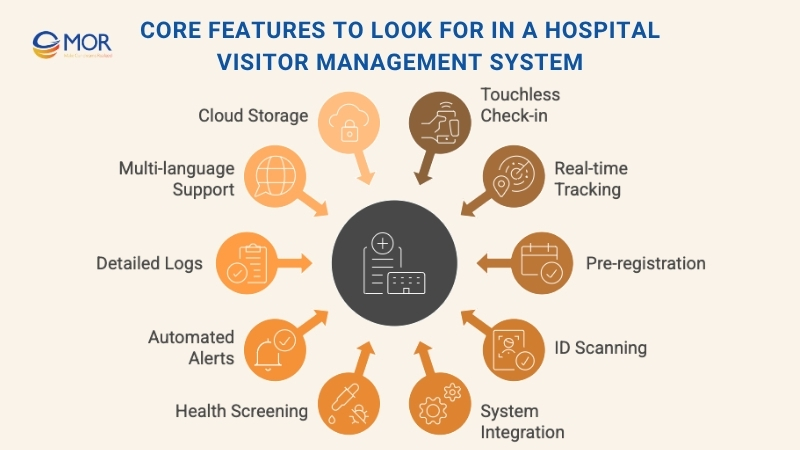
- Integration with access control, EHR, HL7, security systems: A strong hospital visitor management setup should plug into your existing tools, door access, medical records, and alert systems. That keeps your tech stack connected and communication seamless.
- Health screening & compliance: The system should support temperature checks, symptom surveys, and vaccination status when needed. These tools keep hospitals ready to respond to public health requirements.
- Automated alerts and notifications: Whether it’s a flagged guest or a VIP visitor, real-time notifications help staff stay ahead. The healthcare visitor management system should instantly notify hosts, security, or administration when something needs attention.
- Robust logging, analytics, and reporting: Keep detailed records of every check-in and check-out. Whether for contact tracing or audit prep, solid reporting features reduce risk and support planning.
- Multi-language support & customizable workflows: Hospitals serve diverse communities. A system that speaks multiple languages and adjusts workflows based on visit type ensures every guest gets the right experience.
- Cloud-based encrypted storage: Security doesn’t stop at the door. A visitor management system hospital should store all data in the cloud, with encryption to keep records safe and accessible from anywhere.
As cloud computing in healthcare IT spending continues to grow, systems like these are gaining traction. The global digital visitor management market for healthcare is projected to grow at a compound annual growth rate of over 15%, according to Verified Market Reports. This rise reflects growing demand for secure, integrated visitor controls across medical facilities.
Best 10+ Hospital Visitor Management System Options In 2025
We’ve gathered standout platforms making waves in 2025. Each system listed below brings its own mix of smart features, solid reviews, and flexible pricing that fit the needs of modern healthcare facilities.
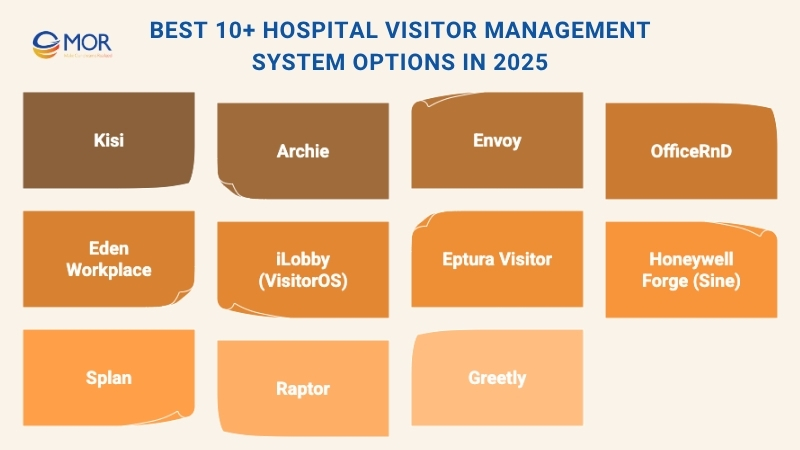
Kisi
Kisi is widely known for its advanced access control setup, and now it brings that same ease to the hospital visitor management system space. With Kisi, hospitals can send out digital invites with access links, alert staff when guests arrive, and maintain searchable logs of all visits.
Visitors can check themselves in using a simple dashboard. Admins can set access permissions based on time and role, using secure QR codes or direct links. This makes it easier to manage traffic across departments and supports long-term planning by analyzing visit trends.
For healthcare facilities needing a complete security suite, Kisi combines visitor tracking with access control and surveillance, all within one platform. This level of control makes it a strong fit for not just hospitals, but clinics, public health agencies, and small healthcare offices.
What users like:
“Kisi lived up to its reputation. From the first call to daily use, the whole process was smooth. We’re very happy with the service.” (Capterra reviewer)
What users don’t like:
“Upgrading hardware can get pricey, though the improvements are noticeable.” (G2 reviewer)
Pricing:
Visit the Kisi pricing page for a free demo and quote. It's a smart move for any hospital looking for a reliable visitor management system hospital setup.
Archie
Archie puts user experience first, making it a great fit for any hospital visitor management system focused on branding and flexibility. With its hrm models, hospitals can offer guests a smooth, branded check-in experience right from their phones or kiosks.
Visitors check in through your own app, not a third-party platform, which keeps the process aligned with your facility's look and feel.
Beyond check-in, Archie also supports room and desk booking, a useful add-on for hybrid staff or specialists needing temporary space. These features help hospitals manage space efficiently, especially in shared or flexible environments.
Archie also syncs directly with Kisi’s access control tools, which means once a visitor checks in, they can instantly receive access credentials. This integration eliminates manual approvals and helps create a unified healthcare visitor management system with tighter security and smoother traffic flow.
What users like:
“Super easy to set up check-in flows. The app is clean, and we get alerts the moment guests arrive.” (Capterra reviewer)
What users don’t like:
“Custom workflow setup took some extra time, but once it was done, it worked great.” (Capterra reviewer)
Pricing:
Plans start at $159/month per location, covering all core tools, including single sign-on. A smart choice for clinics needing a modern free hospital visitor management system alternative that scales.
Envoy
Envoy is a veteran name in the hospital visitor management system category, trusted by many large organizations. Known for simplicity and reliability, the platform makes visitor sign-ins quick and smooth while adding layers of control and customization that hospitals often need.
Admins can set entry rules, pre-screen guests, and send arrival alerts to staff automatically. You can also share visit details like directions, forms, or health guidelines in advance. It’s all managed through a clean dashboard, saving front desk teams time and cutting delays at check-in.
Envoy goes further by including workspace tools like desk and meeting room reservations. For hospitals using hybrid work models or handling rotating staff schedules, these tools can reduce friction. You also get extras like delivery tracking and employee shift coordination.
On the security side, Envoy connects with Kisi, allowing access permissions to sync with the visitor log. That way, guests only gain access once they’re cleared, a key benefit for a visitor management system hospital looking to improve both speed and safety.
What users like:
“No more using Teams or doorbells to notify staff. Envoy handles everything automatically.” (Capterra reviewer)
What users don’t like:
“The license structure takes time to figure out based on what features you need.” (Capterra reviewer)
Pricing:
Envoy offers a free hospital visitor management system option with basic tools, a Standard plan at $109/month/location, and Premium at $329/month/location. Enterprise pricing is available for larger setups. Free trials are also available.
OfficeRnD
OfficeRnD may be best known in the coworking space, but its tools also work well as a hospital visitor management system, especially in private practices or administrative healthcare offices.
Its Visitor Hub module offers a polished check-in experience with features like pre-registration, document collection, and instant arrival notifications via email or mobile.
Customization is where OfficeRnD stands out. Facilities can match the look and feel of the visitor app to their own brand, colors, logos, layouts, and more. This gives guests a consistent and professional first impression from the front desk onward.
The system also supports custom workflows. Hospitals can build check-in flows that meet internal policy or regulatory demands, from signing NDAs and health forms to logging visit data for compliance. Plus, the platform supports delivery management and can connect to Kisi’s access control tools, making it a flexible hospital visitor management solution with real-time access sync.
What users like:
“We chose OfficeRnD because it integrates with so many systems. The onboarding support was excellent, and setup was worth the investment.” (G2 reviewer)
What users don’t like:
“Setup can be tricky if you're not tech-savvy, but it's very flexible once you're in.” (Capterra reviewer)
Pricing:
Visitor Hub is an add-on to OfficeRnD's main plans, starting at €99/month. Visit their pricing page or request a demo for details. It's a solid option for teams needing a scalable healthcare visitor management system with branding control.
Eden Workplace
Eden Workplace offers an all-in-one office management platform that includes a reliable hospital visitor management system for facilities that want easy check-ins and better oversight. It’s designed to help staff pre-register guests, share visit details, and screen for potential safety concerns before anyone walks through the door.
Visitors can fill out forms in advance, sign themselves in at arrival, and automatically trigger host notifications, helping eliminate wait times and confusion at the front desk. It’s a clean, user-friendly system that works well for fast-paced healthcare environments that want to maintain a smooth flow.
Eden also connects with Kisi, syncing access activity directly with visitor logs. That way, entry tracking isn’t just digital, it’s also secure. The system’s flexibility makes it suitable for both small clinics and larger hospitals looking for a visitor management system for hospitals that goes beyond basic check-ins.
What users like:
“The interface is straightforward, and Eden makes daily tasks more convenient.” (Capterra reviewer)
What users don’t like:
“Admin functions could be simpler. Editing floor plans can be a hassle.” (Capterra reviewer)
Pricing:
The Accelerate plan is priced at $89/month/location, while the Scale plan runs $179/month/location and includes visitor photos, file storage, and SSO. Enterprise options with added features are also available. A solid pick for any facility needing a scalable hospital visitor management systems platform.
iLobby
iLobby’s hospital visitor management system, called VisitorOS, is built for high-volume, high-security environments like enterprise search offices, airports, and large healthcare facilities. It goes beyond check-in, it’s a full platform designed to streamline visitor traffic, security protocols, and workplace operations from a single dashboard.
With iLobby, you can pre-register guests, send automatic arrival notifications, and view real-time visit data. It’s built for speed and accuracy, giving administrators full visibility while simplifying the guest experience. The system also delivers advanced reporting, helping hospitals make informed decisions about foot traffic and staffing.
For organizations looking to expand beyond visitor check-ins, VisitorOS integrates with other facility workflows. That includes contractor tracking, deliveries, badge printing, and more, making it ideal for hospitals where different types of guests, vendors, and staff move through various zones daily.
What users like:
“Once a visitor arrives, hosts get notified right away. It’s very automated.” (Capterra reviewer)
What users don’t like:
“Sometimes the badge printer loses connection to the kiosk. We’ve had to restart the system occasionally.” (Capterra reviewer)
Pricing:
iLobby’s base VisitorOS plan starts at $199/month, with advanced features like touchless check-in and on-demand badge printing available from $275/month. Custom enterprise plans are also available, ideal for facilities that need a robust visitor management system hospital setup.
Eptura Visitor
Eptura Visitor, formerly known as Proxyclick, continues to be a strong player in the hospital visitor management system market.
Its platform is built for simplicity and scalability, giving hospitals the tools to manage both scheduled and walk-in visitors with ease. Whether it’s kiosk check-in, remote registration, or custom pre-screening questions, Eptura keeps the process smooth and compliant.
One of its biggest strengths is flexibility. Eptura lets administrators pre-approve guests, share required documents ahead of time, and collect any safety or compliance data needed for access. It’s especially helpful for facilities that require safety briefings, training confirmation, or health documentation prior to arrival.
Eptura also focuses on integrations. It connects easily with your existing tech stack, making it a good choice for hospitals that rely on multiple systems. With its expanding capabilities, it’s becoming a go-to solution for facilities looking for a modern, efficient hospital visitor management tool that adapts as they grow.
What users like:
“Managing all types of visitors is easy. We can collect necessary details, like training requirements, ahead of time.” (Capterra reviewer)
What users don’t like:
“Some features we used with Proxyclick are now extra and cost more under Eptura.” (Capterra reviewer)
Pricing:
Eptura Visitor offers three plans: Core, Advanced, and Power. Pricing is flexible, based on your needs and added features. You can book a demo and talk to the team for more details. It’s a strong fit for hospitals needing a configurable healthcare visitor management system.
Honeywell Forge Visitor Management
Previously known as Sine, Honeywell Forge Visitor Management is a reliable and easy-to-use hospital visitor management system that works well for hospitals of all sizes.
Its setup is quick, and both visitors and admins appreciate how simple it is to use. With contactless sign-in via mobile devices, there’s no need for dedicated kiosks or front-desk staff to handle every guest manually.
Visitors can scan a QR code placed outside the building or entry point to check in on their own. This makes the process faster and more efficient, especially during busy hours. Once checked in, employees receive real-time notifications and can accept or reject visitor access directly from their phones.
The system is designed to keep things moving while maintaining tight control over access. Hospitals that want a self-service setup without complicated hardware will find this option appealing. It’s a strong fit for facilities aiming to modernize their check-in process and reduce reception workload without sacrificing control.
What users like:
“Sine saves us hours of manual work. The interface is friendly for both staff and guests.” (Capterra reviewer)
What users don’t like:
“Customizing the system takes time at first, and some features aren’t intuitive right away.” (Capterra reviewer)
Pricing:
Honeywell Forge offers a basic Sine Core Small plan starting at $69/month/location, built for up to 25 daily check-ins. The Medium plan is $105/month/location, and the Large plan handles up to 150 check-ins per day for $209/month/location. Enterprise options are also available for more complex visitor management system hospital deployments.
Splan
Splan is a flexible, AI-driven hospital visitor management system designed to simplify how guests are checked in while tightening control. The platform supports online pre-registration through both its app and web portal, helping hospitals avoid bottlenecks at reception.
One standout feature is automated background checks, ideal for healthcare environments with strict access policies.
Once a visitor arrives, the system notifies both staff and the visitor in real time. It also allows employees to update visitor details directly, without needing admin support. That kind of autonomy can save time in busy hospital settings where responsiveness matters.
Splan also includes badge printing and facial recognition. Returning guests can be quickly recognized and processed, which helps with frequent contractors, vendors, or family visitors. Badge designs can be tailored to match hospital zones or clearance levels depending on the selected plan, making the system a strong fit for secure, complex facilities.
What users like:
“Highly customizable for secure facilities. It met our detailed contract needs.” (Capterra reviewer)
What users don’t like:
“Our requirements were complex, so setup took longer than expected.” (Capterra reviewer)
Pricing:
Splan’s standard plan includes core tools, with optional add-ons available for a custom setup. You’ll need to contact the team for a quote. It’s a solid option for healthcare teams needing a smart and scalable free hospital visitor management system alternative.
Raptor
While Raptor is best known in the education space, its tools also translate well to healthcare. The platform offers a secure hospital visitor management system that screens every visitor before they enter. Background checks are done in real time, pulling data from state and custom watchlists to flag potential threats and alert security staff right away.
Guests can be screened using questionnaires, either sent ahead of time or completed on-site. For approved visitors, Raptor prints badges that can be customized with the visitor’s name, destination, and other key info. This makes it easier for staff to know who belongs where, reducing confusion and tightening oversight across departments.
One useful feature is Raptor’s ability to generate detailed logs. These reports can cover one facility or an entire hospital network, giving admins a big-picture view of visitor activity and helping with compliance reporting.
What users like:
“Easy to scan or enter visitor info. The badge even shows where they’re headed, which helps staff guide them.” (Capterra reviewer)
What users don’t like:
“The system can buffer at times, and scanned ID data isn’t always perfect.” (Capterra reviewer)
Pricing:
You’ll need to contact Raptor for pricing details. It’s a strong match for hospitals looking for a reliable, safety-first visitor management system for hospitals that covers multiple locations.
Greetly
Greetly by OfficeSpace is a budget-friendly hospital visitor management system that still delivers strong functionality, especially for smaller clinics or satellite healthcare offices. Despite its lower price point, Greetly includes key tools like customizable branding, real-time alerts, and self-service check-ins that cut down on front-desk traffic.
The platform also supports visitor pre-registration, confirmation emails, NDAs, and smooth handoff processes between departments. It’s built for simplicity, with an intuitive kiosk experience that keeps things moving, even when reception is understaffed.
While it may not handle the most complex workflows, Greetly is still a great fit for facilities that need essential check-in tools without paying for extras they won’t use. It’s particularly useful for outpatient clinics, specialty care centers, or any location needing a lightweight hospital visitor management systems solution.
What users like:
“The kiosk is easy to use and has reduced workload at the reception desk.” (Capterra reviewer)
What users don’t like:
“It struggles with more complicated visitor flows and offers minimal personal touch.” (Capterra reviewer)
Pricing:
The Essential plan starts at $99/month when billed annually. The Pro plan, at $159/month, includes extras like badge printing, two-way texting, and ID scanning. Greetly is a practical pick for those seeking a streamlined healthcare visitor management system without high overhead.
How To Choose The Right Hospital Visitor Management System?
Every hospital operates differently, but the right hospital visitor management system should make things easier, not harder. It should improve safety, streamline workflows, and reduce manual work at the front desk. Before making a decision, focus on features that align with your facility’s real needs.
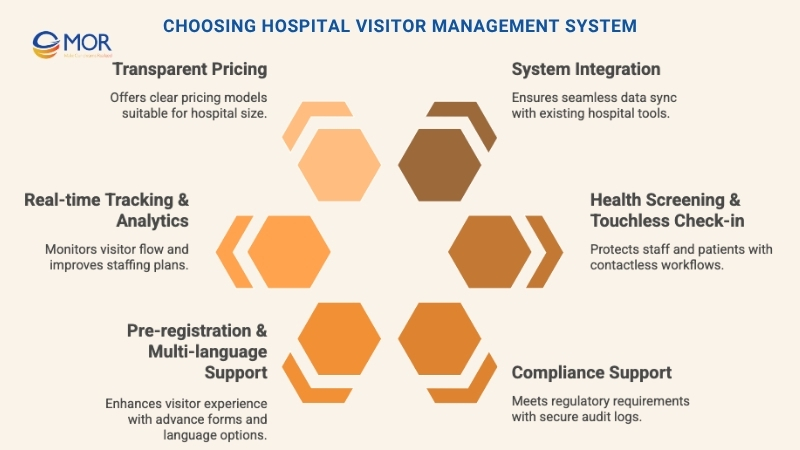
When evaluating options, you should prioritize:
- Integration with your access control, EHR, and security systems: Make sure the system connects with your existing tech stack. That way, visitor logs sync with access permissions, medical records, and security alerts without extra steps.
- Health screening and touchless check-in: Built-in tools like temperature checks, symptom surveys, and QR code sign-ins help protect staff and patients while speeding up entry.
- Compliance features (HIPAA, audit logs): Look for systems that maintain secure, time-stamped records and meet healthcare privacy standards. This is essential for audit readiness.
- Pre-registration and multi-language workflows: Let visitors complete forms in advance and choose their preferred language. This reduces wait times and ensures a smoother experience for everyone.
- Real-time tracking, analytics, and visitor data management: Dashboards that show who’s on-site and for how long support better staffing, safety, and space planning.
- Clear cost structure: Choose a pricing model that fits your usage, whether that’s per visit, per bed, or per location. Vendors offering trials or demos help you make an informed decision before committing.
Build Custom Hospital Visitor Management Systems With MOR Software
Off-the-shelf tools can’t always handle the complexity of a hospital. That’s where we come in.
MOR Software builds custom visitor management systems tailored for healthcare environments, systems that connect seamlessly with your EHR, support multi-language check-ins, and keep you compliant with HIPAA, CDC, and local health mandates.
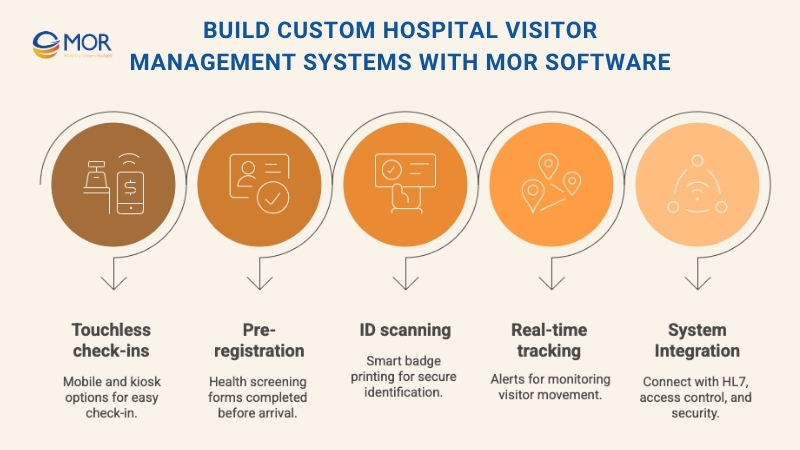
We support:
- Touchless mobile or kiosk check-ins
- Pre-registration with health screening forms
- ID scanning and smart badge printing
- Real-time visitor tracking and alerts
- Integration with HL7, access control, and security tools
We’ve already helped hospitals roll out secure apps like I-Medisync and Procuratio. So we know the stakes and how to get it right.
Need to modernize a paper-based system? Or build one from scratch that can scale across multiple sites? We’ll guide you through it, from planning to post-launch support.
Let’s make hospital visits safer, smoother, and smarter. Together.
Conclusion
Choosing the right hospital visitor management system isn’t just about tech. It’s about protecting people, improving workflows, and staying audit-ready. The best systems combine security, speed, and flexibility to match how your hospital actually runs. Whether you need better screening, smoother check-ins, or stronger compliance, the right tool makes a real difference.
Need a custom solution built around your facility? Contact MOR Software to build a system tailored to your needs.
MOR SOFTWARE
Frequently Asked Questions (FAQs)
What types of hospitals need a visitor management system?
Any hospital, from large urban medical centers to small community clinics, can benefit from a visitor management system. It’s especially useful for facilities with high foot traffic, strict security protocols, or infection control needs.
Can a visitor management system help with emergency response?
Yes. Real-time dashboards and visitor logs give staff an instant view of who is in the building. In emergencies, this data supports evacuation procedures and quick communication.
Is hospital visitor data stored securely?
Yes. Most modern systems use cloud-based encrypted storage and follow data compliance standards like HIPAA. Hospitals should always review vendor policies before implementation.
Does it work for recurring visitors like family members or vendors?
Absolutely. Many systems support pre-registration, reusable visitor profiles, and role-based access so frequent guests can check in faster while still meeting security checks.
How does a visitor management system support infection control?
Touchless check-in, health screening questions, and temperature capture reduce physical contact and help detect possible risks before entry.
Rate this article
0
over 5.0 based on 0 reviews
Your rating on this news:
Name
*Email
*Write your comment
*Send your comment
1